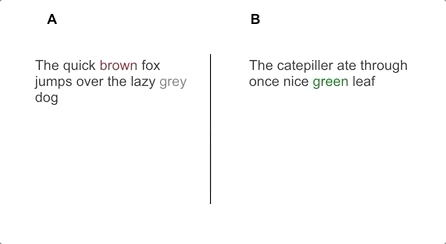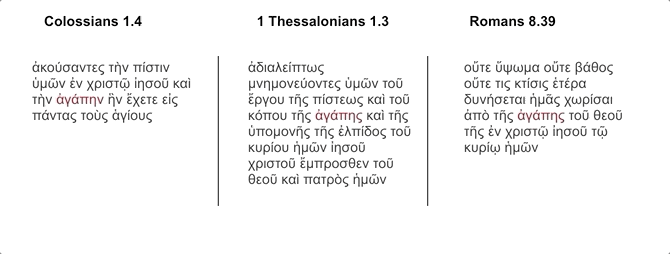The goal of textych is to create interactive text parallels. This form of reference is useful for exploring similarities and differences betwixt passages.
You can install the released version of textych from GitHub with:
remotes::install_github("daranzolin/textych")Split any text into words and assign a corresponding color and tooltip.
library(textych)
library(tidytext)
library(dplyr)
df <- tibble(
text = c("The quick brown fox jumps over the lazy grey dog",
"The catepiller ate through once nice green leaf"),
ind = c("A", "B")
) %>%
unnest_tokens(word, text, to_lower = FALSE) %>%
mutate(
color = case_when(
word == "brown" ~ "brown",
word == "grey" ~ "grey",
word == "green" ~ "green",
TRUE ~ "#333333"
),
tooltip = case_when(
word == "caterpillar" ~ "An insect",
word %in% c("fox", "dog") ~ "A cute mammal",
word == "leaf" ~ "Vegetation"
)
)
textych(df, text = word, text_index = ind, color = color, tooltip = tooltip)Arranging parallel texts with similar language and ideas is a common practice in textual analysis, and there is very expensive software that parses each word's form, tense, mood, gender, case, etc. This is a cheaper (and more customizable) alternative.
First, I load the packages, then retrieve and parse the texts via rperseus.
library(rperseus) # remotes::install_github("ropensci/rperseus")
library(glue)
texts <- bind_rows(
get_perseus_text("urn:cts:greekLit:tlg0031.tlg012.perseus-grc2", "1.4"),
get_perseus_text("urn:cts:greekLit:tlg0031.tlg013.perseus-grc2", "1.3"),
get_perseus_text("urn:cts:greekLit:tlg0031.tlg006.perseus-grc2", "8.39")
)
parsed_texts <- bind_rows(
parse_excerpt("urn:cts:greekLit:tlg0031.tlg012.perseus-grc2", "1.4"),
parse_excerpt("urn:cts:greekLit:tlg0031.tlg013.perseus-grc2", "1.3"),
parse_excerpt("urn:cts:greekLit:tlg0031.tlg006.perseus-grc2", "8.39")
)Second, I want to (1) specify title labels; (2) color the word ἀγάπη ("love"); and (3) create a custom HTML tooltip parsing each word on hover.
tt_data <- texts %>%
transmute(
text,
passage = glue("{label} {section}")
) %>%
unnest_tokens(word, text) %>%
left_join(
distinct(parsed_texts, word, form, .keep_all = TRUE),
by = c("word" = "form")
) %>%
mutate(color = ifelse(grepl("ἀγάπη", word), "firebrick", "#333333")) %>%
mutate(tooltip = glue("<table>
<tr>
<th>word</th>
<th>part</th>
<th>number</th>
<th>gender</th>
<th>case</th>
</tr>
<tr>
<td>{word.y}</td>
<td>{part_of_speech}</td>
<td>{number}</td>
<td>{gender}</td>
<td>{case}</td>
</tr>
</table>
")
)Finally, I pass the data to textych, specifying the respective columns for each parallel, text color, and tooltip.
textych(tt_data, word, passage, color, tooltip)- Highlighting words
- More easily customizable tooltips
- Additional styling
- Improved margins

